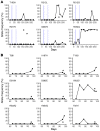Human parainfluenza virus evolution during lung infection of immunocompromised individuals promotes viral persistence
- PMID: 34609969
- PMCID: PMC8631596
- DOI: 10.1172/JCI150506
Human parainfluenza virus evolution during lung infection of immunocompromised individuals promotes viral persistence
Abstract
The capacity of respiratory viruses to undergo evolution within the respiratory tract raises the possibility of evolution under the selective pressure of the host environment or drug treatment. Long-term infections in immunocompromised hosts are potential drivers of viral evolution and development of infectious variants. We showed that intrahost evolution in chronic human parainfluenza virus 3 (HPIV3) infection in immunocompromised individuals elicited mutations that favored viral entry and persistence, suggesting that similar processes may operate across enveloped respiratory viruses. We profiled longitudinal HPIV3 infections from 2 immunocompromised individuals that persisted for 278 and 98 days. Mutations accrued in the HPIV3 attachment protein hemagglutinin-neuraminidase (HN), including the first in vivo mutation in HN's receptor binding site responsible for activating the viral fusion process. Fixation of this mutation was associated with exposure to a drug that cleaves host-cell sialic acid moieties. Longitudinal adaptation of HN was associated with features that promote viral entry and persistence in cells, including greater avidity for sialic acid and more active fusion activity in vitro, but not with antibody escape. Long-term infection thus led to mutations promoting viral persistence, suggesting that host-directed therapeutics may support the evolution of viruses that alter their biophysical characteristics to persist in the face of these agents in vivo.
Keywords: Influenza; Virology.
Figures








Similar articles
-
Adaptation of human parainfluenza virus to airway epithelium reveals fusion properties required for growth in host tissue.mBio. 2012 Jun 5;3(3):e00137-12. doi: 10.1128/mBio.00137-12. Print 2012. mBio. 2012. PMID: 22669629 Free PMC article.
-
Interaction between the hemagglutinin-neuraminidase and fusion glycoproteins of human parainfluenza virus type III regulates viral growth in vivo.mBio. 2013 Oct 22;4(5):e00803-13. doi: 10.1128/mBio.00803-13. mBio. 2013. PMID: 24149514 Free PMC article.
-
Human parainfluenza virus infection of the airway epithelium: viral hemagglutinin-neuraminidase regulates fusion protein activation and modulates infectivity.J Virol. 2009 Jul;83(13):6900-8. doi: 10.1128/JVI.00475-09. Epub 2009 Apr 22. J Virol. 2009. PMID: 19386708 Free PMC article.
-
New antiviral approaches for human parainfluenza: Inhibiting the haemagglutinin-neuraminidase.Antiviral Res. 2019 Jul;167:89-97. doi: 10.1016/j.antiviral.2019.04.001. Epub 2019 Apr 3. Antiviral Res. 2019. PMID: 30951732 Review.
-
Activation of paramyxovirus membrane fusion and virus entry.Curr Opin Virol. 2014 Apr;5:24-33. doi: 10.1016/j.coviro.2014.01.005. Epub 2014 Feb 16. Curr Opin Virol. 2014. PMID: 24530984 Free PMC article. Review.
Cited by
-
A robust mouse model of HPIV-3 infection and efficacy of GS-441524 against virus-induced lung pathology.Nat Commun. 2024 Sep 5;15(1):7765. doi: 10.1038/s41467-024-52071-5. Nat Commun. 2024. PMID: 39237507 Free PMC article.
-
Murine parainfluenza virus persists in lung innate immune cells sustaining chronic lung pathology.Nat Microbiol. 2024 Nov;9(11):2803-2816. doi: 10.1038/s41564-024-01805-8. Epub 2024 Oct 2. Nat Microbiol. 2024. PMID: 39358466
-
Human parainfluenza virus 3 field strains undergo extracellular fusion protein cleavage to activate entry.mBio. 2024 Nov 13;15(11):e0232724. doi: 10.1128/mbio.02327-24. Epub 2024 Oct 9. mBio. 2024. PMID: 39382296 Free PMC article.
-
Unraveling dynamics of paramyxovirus-receptor interactions using nanoparticles displaying hemagglutinin-neuraminidase.PLoS Pathog. 2024 Jul 25;20(7):e1012371. doi: 10.1371/journal.ppat.1012371. eCollection 2024 Jul. PLoS Pathog. 2024. PMID: 39052678 Free PMC article.
-
Functional and structural basis of human parainfluenza virus type 3 neutralization with human monoclonal antibodies.Nat Microbiol. 2024 Aug;9(8):2128-2143. doi: 10.1038/s41564-024-01722-w. Epub 2024 Jun 10. Nat Microbiol. 2024. PMID: 38858594 Free PMC article.
References
-
- Lo MS, et al. The impact of RSV, adenovirus, influenza, and parainfluenza infection in pediatric patients receiving stem cell transplant, solid organ transplant, or cancer chemotherapy. Pediatr Transplant. 2012;17(2):133–143. - PubMed

